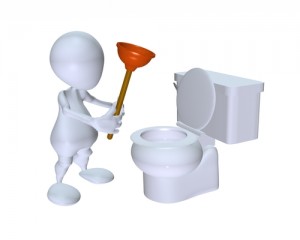Last week, in Pichel v. Dryden Mutual Ins. Co., — N.Y.S. 2d —, 2014 WL 1923736 (May 15, 2014), an intermediate level appellate panel in New York brought the state into line with the interpretation of water backup adopted by a number of other jurisdictions. The decision held that policy references to a “plumbing system” mean the plumbing system on the insured premises itself. As a result, a loss caused by water which backs up through sewers and drains is covered if the overflow originated within the insured’s property but excluded if the backup originated off site, as from a clogged municipal sewer system for example.
 The policyholder owned an apartment complex that was insured by Dryden Mutual. The structure was damaged when waste water inundated the first floor, entering the units through toilets, bathtubs, and drains. The insurer denied liability, contending that coverage was barred by two “Water Damage” exclusions. The first recited that loss caused by “water which backs up through sewers and drains” was excluded, while the second barred coverage for “loss caused by repeated or continuous discharge, or leakage of liquids or steam from within a plumbing … system.” The second of these exclusions, however, went on to state that Dryden Mutual would pay for “loss caused by the accidental leakage, overflow or discharge of liquids or steam from a plumbing … system.”
The policyholder owned an apartment complex that was insured by Dryden Mutual. The structure was damaged when waste water inundated the first floor, entering the units through toilets, bathtubs, and drains. The insurer denied liability, contending that coverage was barred by two “Water Damage” exclusions. The first recited that loss caused by “water which backs up through sewers and drains” was excluded, while the second barred coverage for “loss caused by repeated or continuous discharge, or leakage of liquids or steam from within a plumbing … system.” The second of these exclusions, however, went on to state that Dryden Mutual would pay for “loss caused by the accidental leakage, overflow or discharge of liquids or steam from a plumbing … system.”
The policyholder brought suit state in New York, and the trial court found that the provisions were ambiguous but could be reconciled if read so as to bar coverage for backup that originated off the insured’s property (i.e., in a municipal sewer or drain) while affording coverage for an occurrence originating within the insured’s property (i.e., in the property owner’s own plumbing system). It therefore granted partial summary judgment to the insured.
On appeal, New York’s Appellate Division agreed. The issue was one of first impression in New York state, but the appellate court noted that other jurisdictions had interpreted the interplay between these two competing provisions in just that fashion, holding that the term “plumbing system” included the drains that are on the insured’s own premises. It then adopted a similar rule, holding that “water damage caused by a backup/overflow that originates from a pipe or clogged drain located within the insured’s property line comes from the insured’s plumbing system and is covered by the policy [while] if the cause of the backup/overflow is from outside the insured’s property boundaries – such as a clogged municipal sewer that forces water from outside the insured’s plumbing system to overflow – the sewer or drain exclusion is applicable.” In the words of the court, such an interpretation “affords full effect to both the exclusion and coverage provisions and is consistent with the … case law of other jurisdictions.”
The case was nonetheless remanded because the Appellate Division held that the policyholder had not met his burden of showing that there were no issues of fact with respect to what happened.

